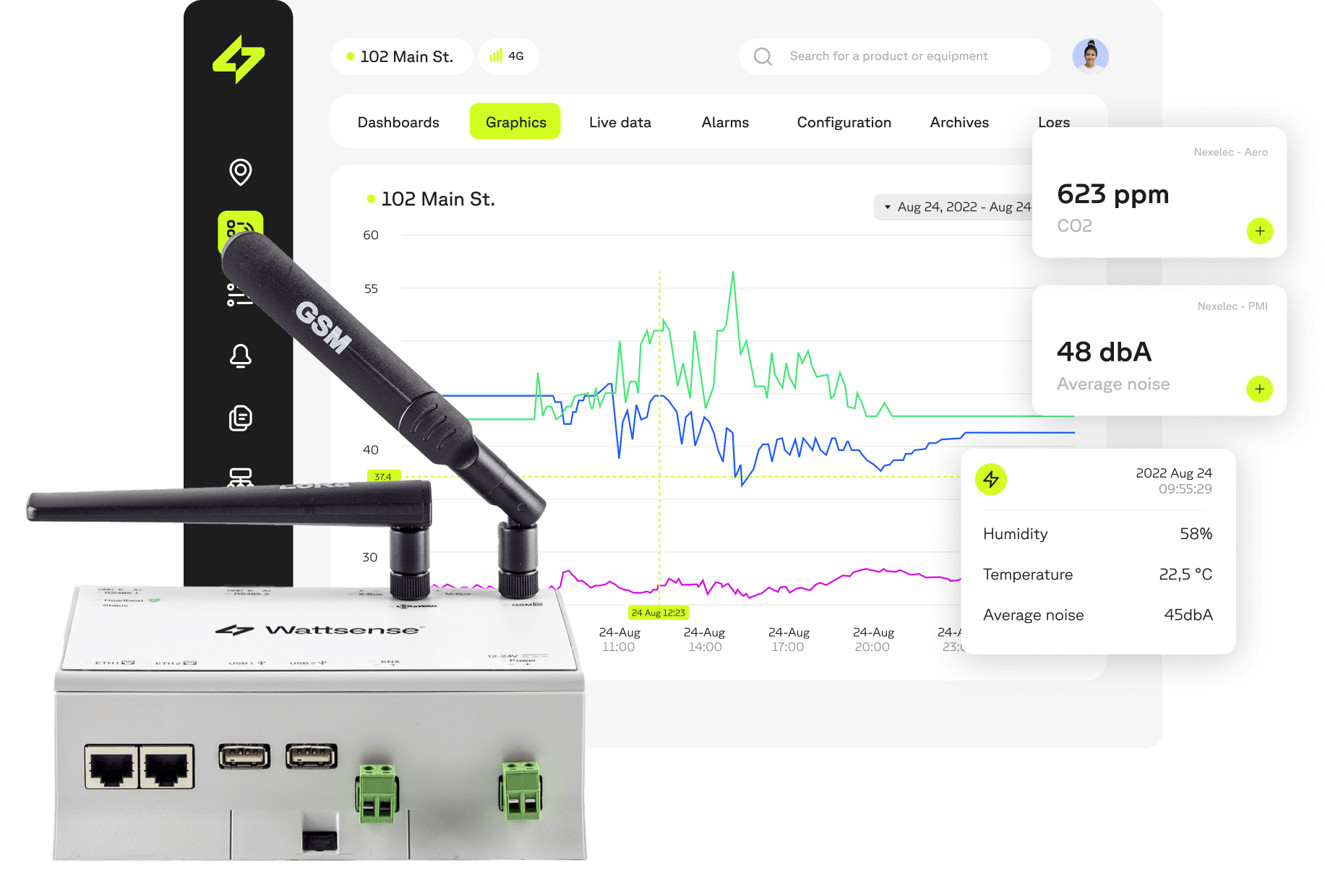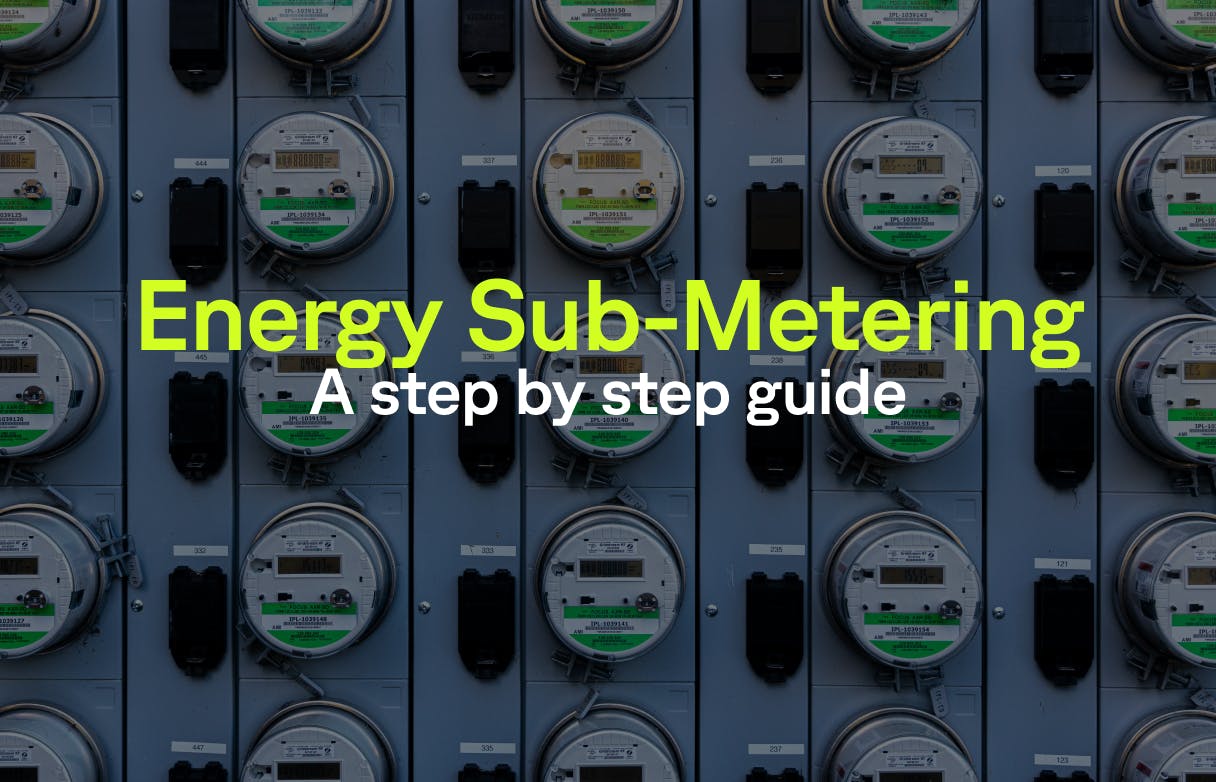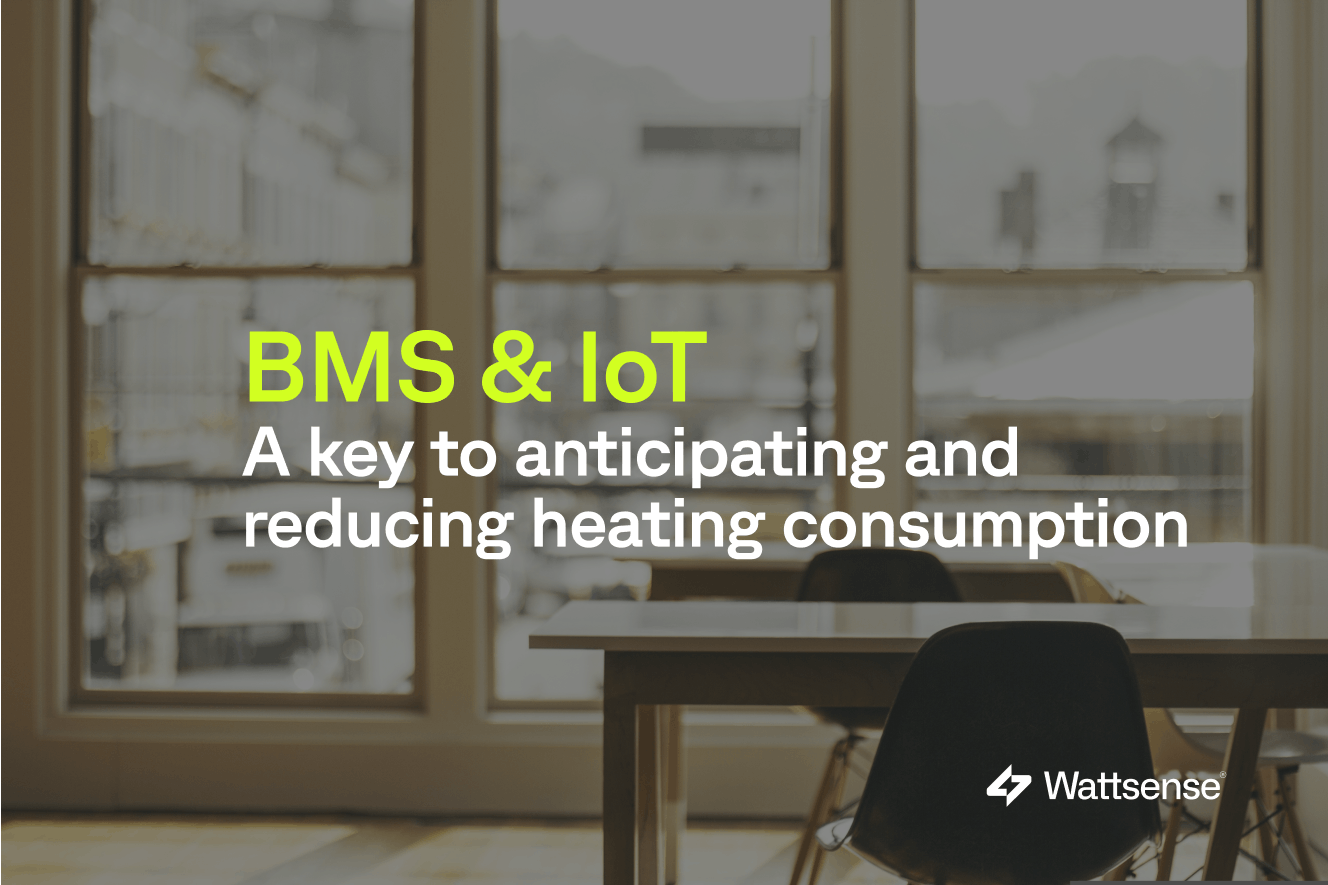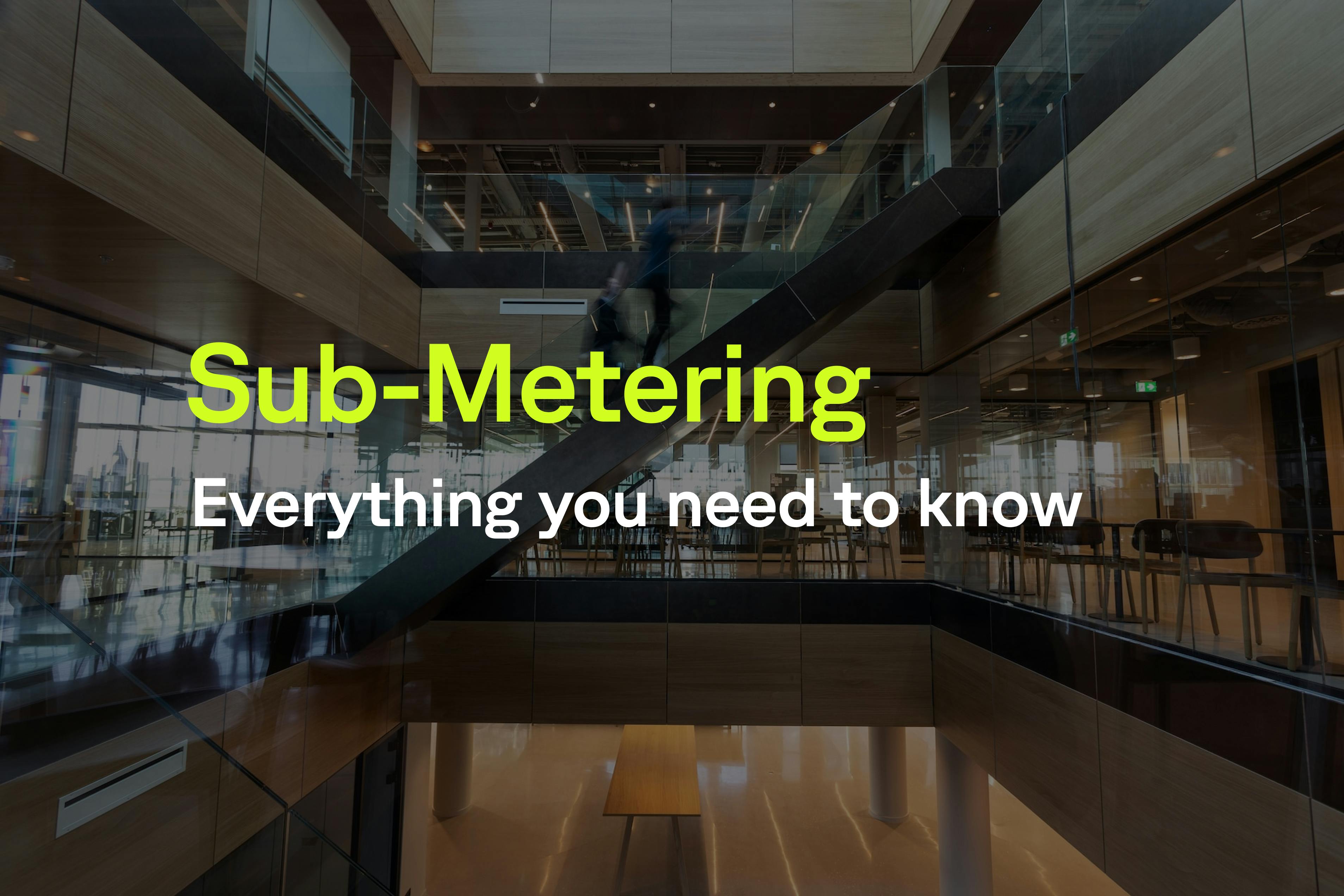Energy optimization of buildings: challenges and solutions

In a context where energy issues are intensifying, companies and property owners are faced with growing pressure: rising prices, regulatory obligations and environmental policies. Optimizing the energy efficiency of buildings is therefore emerging as an absolute priority. Central to this approach, connectivity and intelligent building management are key to achieving maximum energy efficiency.
Wattsense technology is an intuitive connectivity solution that helps reduce your energy consumption. Our solution facilitates the technical and energy management of buildings, regardless of their size or condition. Find out more here.
What is energy optimization?
Energy optimization leads to more efficient energy management within a building. Its main purpose is to reduce energy consumption, and its associated costs. It involves not only direct savings on energy bills, but also minimization of costs associated with equipment repairs (better maintenance) and other indirect expenses.
Energy optimization encompasses concrete actions such as choosing more efficient equipment, reducing heat loss and eliminating waste.
To summarize, energy optimization is the constant search for new ways to save energy, without affecting the building's operational efficiency (production volume, team productivity, service quality and occupant comfort).
The challenges of building energy optimization
Environmental Challenges: reduce your carbon footprint
Energy optimization addresses the need to reduce the carbon footprint of buildings during their operational phase. Compared to the transportation sector, the building sector (whether for residential, commercial, or industrial use) is the most polluting in terms of greenhouse gas emissions. It logically requires swift and effective actions.
Opting for cleaner installations is now essential to contributing to a sustainable future, regardless of your industry or the size of your property.
Economic Challenges: achieve Energy Savings
By consuming less energy, you reduce your energy bills, thereby strengthening your company's financial health.
By reducing energy costs, your company improves its competitiveness. A high level of energy efficiency becomes a competitive advantage in a context of sharply rising energy prices.
Of course, the notion of return on investment is essential in any approach to energy optimization. To reduce consumption and make real financial savings, an initial (well-targeted) investment is often essential.
Societal issues: enjoy more comfortable building
Energy optimization contributes directly to improving the comfort of building occupants. This includes aspects such as thermal comfort (both in winter and summer), appropriate lighting, access to high-performance equipment, effective solar shading, etc.
By taking into account the health and comfort of employees, this approach is in line with corporate social responsibility (CSR). A healthier, more pleasant indoor environment is promoted, contributing to the overall well-being of all occupants (customers, employees, users).
Regardless of your sector of activity, actions in favor of better resource management enhance your brand image. Your customers and (future) employees are often sensitive to your efforts to move towards environmentally-friendly operations.
Regulatory issues: responding to current energy policies
Climate change has put the energy transition at the heart of national and international concerns. Laws and regulations in favor of better resource management are multiplying, for both new and existing buildings. Here are just a few examples:
- EPC ratings (Energy Performance Certificates) exist and allow a building to be rated from A to G based on various factors: the age of the building, the materials used, the carbon footprint, and more.
- DEC ratings (Display Energy Certificates) are available for public buildings. A DEC indicates the energy performance of a building based on actual energy consumption recorded over the last 12 months during the validity period of the DEC (the operational rating).
To meet the government's ambitious targets, we need to think globally about the way we use energy in buildings. Energy renovation alone is no longer sufficient to achieve significant and lasting energy optimization.
How to optimize energy: solutions to consider
Improving installations: carrying out energy renovation work
The first option, and often the most impactful in older buildings, is to act on the building envelope by improving its thermal insulation and/or airtightness. This priority action reduces heat loss (leakage), thus improving the overall energy efficiency of the building.
The second action involves replacing energy-hungry or low-efficiency equipment. This includes installing more efficient, better-sized appliances that are less dependent on fossil fuels.
Finally, rigorous maintenance of all equipment is essential to ensure that it retains its performance (and therefore optimum efficiency) over the long term.
Better use of equipment
Once the priority actions with the greatest impact have been carried out, you can implement more detailed energy optimization. For example, you may program your heating or air-conditioning equipment according to your operating hours. Lighting can also be programmed to operate at specific times (e.g. outdoor illuminated signs). Presence and brightness detectors can also be added to optimize lighting costs.
With a view to optimizing your performance, integrating a building management system (BMS) gives you a global view of your building's behavior at every level. Thanks to a range of customized measurement points, it allows for real-time monitoring and active management of your resources.
You want smarter energy management?
Our connectivity solution allows you to optimize the energy efficiency of your building while keeping costs under control. By taking control of your equipment (sensors, heaters, submeters, etc.), you can adjust your consumption to match your actual needs more precisely.

Integrating renewable energies: kick-start your energy transition
Another way to improve your energy efficiency is to integrate renewable energy sources. The aim is to gradually move away from fossil fuels in favor of cleaner, more sustainable solutions.
The installation of air/air heat pumps, photovoltaic solar power plants or hybrid boilers offers less energy-intensive alternatives to “all-electricity”. In addition to the environmental benefits, this approach offers protection against rising energy prices, reinforcing your long-term financial stability.
Involving occupants: raising employee awareness
The success of an energy optimization program depends on more than just the quality of the installations. It is often essential to involve occupants and make them aware of the positive impact of good day-to-day practices.
If necessary, a short training course in the use of equipment (particularly connected/programmed equipment) may prove useful.
How do you measure energy savings?
The importance of initial diagnosis: measure to improve
To optimize your energy consumption, you first need to know it! How much electricity/gas do you consume? What are your biggest consumption items? Is your consumption linear, or does it fluctuate according to season or time of day? It's difficult to improve a parameter that hasn't been measured beforehand.
To do this, you can carry out an energy audit. This is the first step towards assessing your needs. The energy audit can be carried out for residential, commercial, and even facility-specific purposes within a building.
You can also carry out a more detailed measurement of your consumption over a significant period. Electricity sub-metering provides a detailed understanding of your consumption habits. It identifies areas of waste and highlights opportunities for improvement.
This initial diagnosis will enable you to set a consumption reduction target in line with your financial resources and the condition of your building. It serves as the basis for drawing up a relevant action plan.
The Wattsense connected solution is an invaluable tool for collecting your consumption data during the initial assessment. Easy to deploy, it connects to your sub-meters and provides an overview of your site's energy behavior.
Energy Performance Certificate (EPC).
An EPC, or Energy Performance Certificate, is a document that assesses the energy consumption of a building and its efficiency in the form of a rating. EPCs take into account the amount of energy used by the building, including how efficiently it uses energy for its equipment.
The United Kingdom is gradually introducing a higher standard rating for rental properties, currently set at E. This is expected to rise to C as the minimum requirement by 2026.
This protocol is often established between a property owner and a company. It ensures a level of performance to be achieved by the end of the contract.
For example, the contracting company must reduce the energy consumption of a site by 25% within 5 years.
Here are some benefits of using a building’s EPC rating:
- Increase property value
- Lower monthly bills thanks to improved energy efficiency
- Cheaper mortgages for the owner with increased rental value
- Extended building lifespan
The DEC, the energy performance rating of a building.
As a building owner, you are required to have a Display Energy Certificate (DEC).
A Display Energy Certificate (DEC) reflects the energy performance of a building based on its actual energy consumption over a 12-month period. This measurement is essential during the validity of the DEC, as it represents what is known as the "operational rating."
The operational rating is a numerical indicator of the annual carbon dioxide (CO2) emissions generated by the building. To make relevant comparisons between different buildings, it is crucial to group the various types of energy consumption under a standard unit. In the United Kingdom, the chosen unit of measurement is CO2 emissions, which is a central element of energy policy.
Buildings are rated on a scale from A to G, where A indicates the lowest CO2 emissions, signifying better energy performance, while G corresponds to the highest emissions, indicating less favorable performance.
Additionally, for buildings over 1,000 square meters, the DEC also includes performance ratings from the previous two years, if available, providing a historical overview of energy performance.
Source: Gov.UK
Connectivity: the key to successful energy optimization
Connectivity is emerging as the fundamental pillar of energy optimization. The ability to link various systems and devices to share information in real time creates an interconnected ecosystem.
Thanks to this dynamic monitoring, we are now able to continuously measure, analyze and adjust parameters to further optimize energy performance.
By reacting (almost in real time) to any anomalies or energy wastage observed, the savings are real (including in terms of cost).
Data collection isn't an end in itself if it can't be used. The added value of a high-performance solution lies in its ease of use and its ability to make information readable for users. The interoperability of different applications is a key factor in the success of an energy optimization program.
Connectivity is therefore a real thread leading you towards more refined energy management.
Wattsense technology allows you to take the first step towards your performance projects. Compatible with various communication protocols, it facilitates integration with all your existing equipment (without the need to replace it).
Designed for maximum readability, the Wattsense console offers you visual monitoring and reporting tools. Track your energy consumption, savings and the impact of your optimization measures.
Discover the Wattsense connectivity solution today, or request a personalized demo to find out more.
Want to learn more about the Wattsense connectivity solution?
Discover our solutionContinue reading



